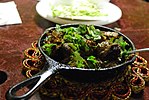This article needs additional citations for verification. (November 2011) |
 |
| This article is part of the series |
| Pakistani cuisine پاکستانی پکوان |
|---|


| Part of a series on the |
| Culture of Pakistan |
|---|
 |
| Traditions |
| folklore |
| Sport |
Pakistani cuisine (Urdu: پاکستانی پکوان, romanized: pākistānī pakwān) can be characterized as a blend of regional cooking styles and flavours from across South, Central and West Asia. Pakistani cuisine is influenced by Persian, Indian, and Arab cuisine. The cuisine of Pakistan also maintains certain Mughal influences within its recipes and cooking techniques.[2][3] Pakistan's ethnic and cultural diversity, diverse climates, geographical environments, and availability of different produce lead to diverse regional cuisines.
Pakistani cuisine, as in the food culture of most Muslim nations, is structured around halal principles, which, for example, forbid pork and alcohol consumption in accordance with Sharia law, the religious laws of Islam. Many more details of halal regulations apply to meats, which types of animals are acceptable or “clean” for human consumption.
International cuisine and fast food are popular in major cities such as Islamabad[4] and Karachi;[5] blending local and foreign recipes (fusion food), such as Pakistani Chinese cuisine, is also common in large urban centres. As a result of lifestyle changes, health trends, and new dietary research being published, traditional ingredients such as masala (pre-mixed and ready-to-use) and ghee (clarified butter)—with its health benefits and high smoke point—have been increasingly popular.
- ^ "Port Grand (Karachi) - 2021 All You Need to Know Before You Go (Photos) - Karachi, Pakistan". Archived from the original on 16 June 2020. Retrieved 16 June 2020.
- ^ Taus-Bolstad, S (2003), Pakistan in Pictures. Lerner Publishing Group. ISBN 978-0-8225-4682-5
- ^ Jonathan H. X. Lee, Kathleen M. Nadeau Encyclopedia of Asian American Folklore and Folklife, Volume 1 page 973 ABC-CLIO, 2011 ISBN 0313350663, 9780313350665
- ^ Arshad, Nabiha (24 October 2023). "Top 15 Fast Food Restaurants in Islamabad". Menu Point. Retrieved 15 January 2024.
- ^ "Top 15 Fast Food Restaurants in Karachi". Menu Point. 28 October 2023. Retrieved 15 January 2024.